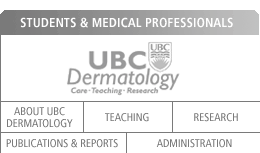|
 |
 |
 |
Frequently Asked Questions
What about Rogaine or other hair-inducement products on the market?
- There are many myths and inaccuracies about these and other types of treatments.
- Our specialist Dermatologists can help you determine if you are a candidate for Rogaine, Finasteride or other hair growth products, and can describe the realistic results you should expect from them.
- It is important to get accurate medical facts before starting on any medical hair growth treatment program.
What causes hair loss?
- In typical genetic baldness, the hormone DHT (dihydrotestosterone) causes certain hair follicles to weaken, miniaturize and eventually shed.
- The hair follicles on the back and lower sides of the scalp are not affected by DHT.
- Hair at the front, above the temples, top of scalp and crown can all be DHT-sensitive, depending on your genetic makeup.
- In addition to male/female pattern baldness, however, there are certain medications, hormonal changes, diseases (such as lupus or diabetes) and other major stressors to the body that can trigger hair loss. Our dermatologists can assess you for these conditions
How does transplantation circumvent DHT?
- Transplantation uses hair grafts taken from your donor areas on the back of the scalp, where follicles are not affected by DHT.
- When these grafts are transplanted to the front, crown or top of the scalp, they retain their resistance to DHT and last a lifetime.
Is hair transplantation painful?
- Patients report only a small amount of discomfort associated with hair transplant surgery.
- Some patients, if requested, can be given a relaxing medication prior to the procedure that improves the whole hair transplant experience.
- A headache may develop on the evening of the procedure but rarely lasts beyond that time.
- Swelling can be experienced around the forehead and eye area the day after the surgery, but it is not painful or permanent.
- The risk for infection and other problems is very rare.
How many treatments will I need?
- The number of treatments required will depend on your personal desires, the extent of your hair loss, and your available donor area.
- It takes about six months to appreciate your new growth. That is a good time to return for further evaluation and to see if more sessions are desired or needed.
Will my new hair look natural?
- Throughout the world, hair transplant surgeons use a variety of techniques to transfer hair from the donor areas to the recipient sites. These established techniques will have your new hair looking and feeling so natural, not even your hair dresser may know the difference unless you tell them!
- If you have more questions, the Hair Transplant Centre has a dedicated website that will provide you with more insight and information. Follow this link for more: Hair Transplant Centre.
To schedule a consultation please call us at 604-875-5446.
« Back to Hair Loss
|
|
 |
|

